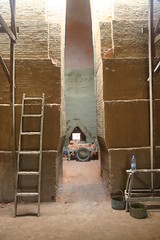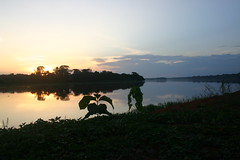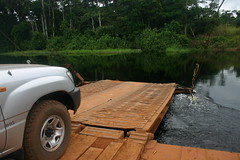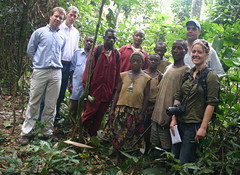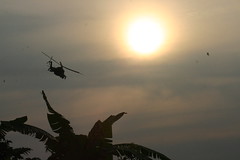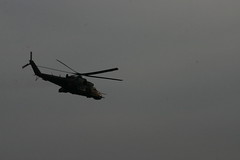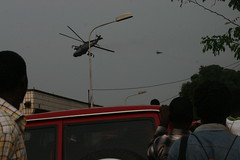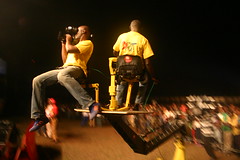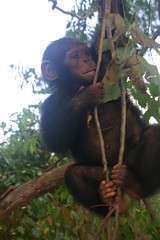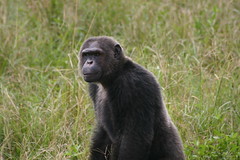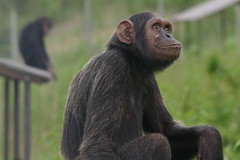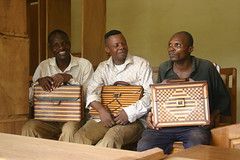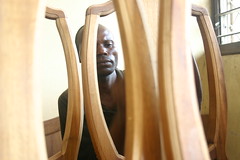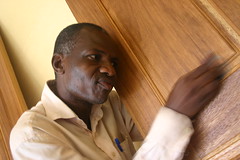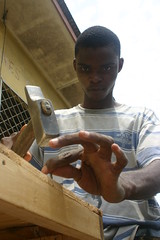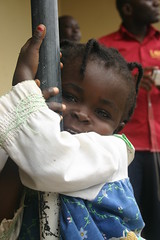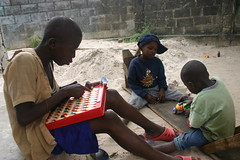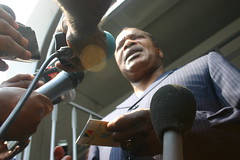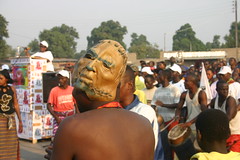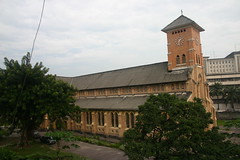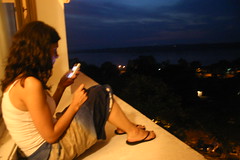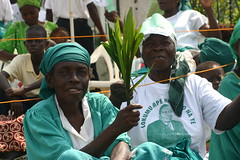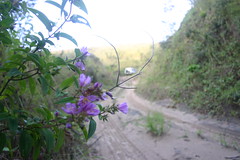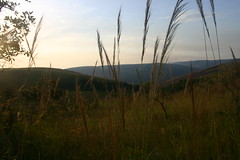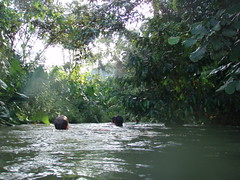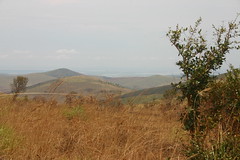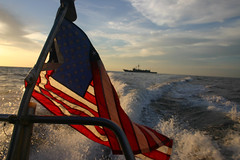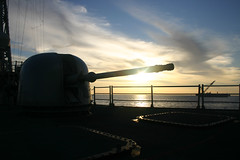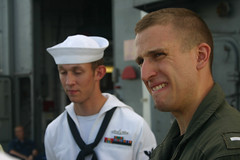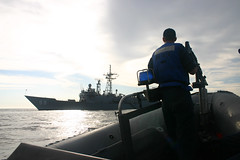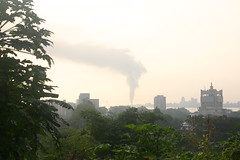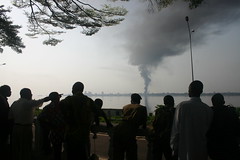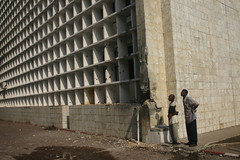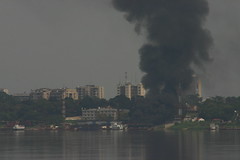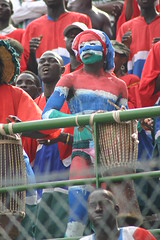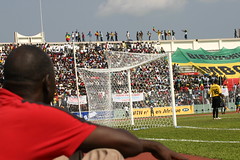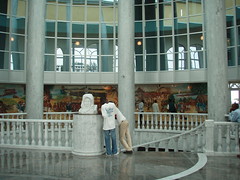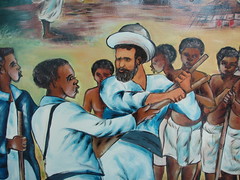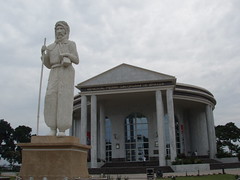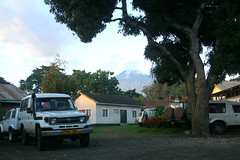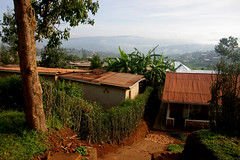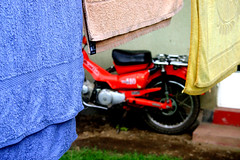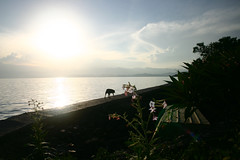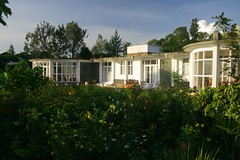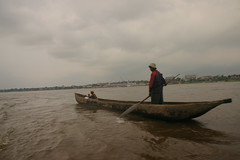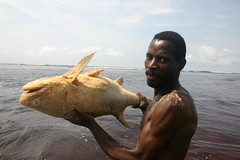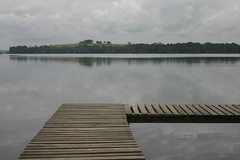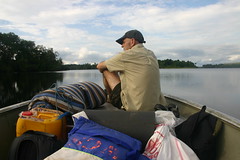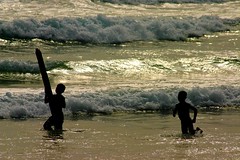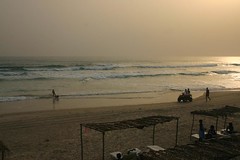Pokola visit, 2007
At the end of my time in Congo, I visited CIB’s logging operations in the far north of Congo close to the border with Cameroon. I did stories on logging and also the innovative work the company is doing in helping pygmies map out their forest.
The Ninjas arrive, 2007
On a warm day in September, rebel leader Pasteur Ntumi, was due to come into Brazzaville to take up a post in the government. The Ninjas had controlled the Pool region to the west of the capital since the civil war in the 1990s. They’re a mystical sect that wear a lot of purple and look like rastas. Unlike their peace-loving equivalents though, the Ninjas are armed to the teeth and somehow succeeded in keeping the government army at bay, something many Congolese attribute to mystical powers. I wasted a couple of hours waiting at the presidential palace where nothing was happening. I wrote a little colour piece which was never used in the end, but which I’ll print below:
It was supposed to be a significant day in the final stages of the peace process in Congo-Brazzaville. Instead, it ended with military attack helicopters swooping down on the former rebels and their instant rearmament.
Former rebel leader Pastor Ntumi was supposed to be at the People’s Palace in the morning. After leaving the capital Brazzaville in 1997 to fight a rebel war against President Denis Sassou-Nguesso, he was now expected to take up a position in government as a junior minister responsible for peace and reparations.
It soon became clear that there were some last minute difficulties between the government and the ex-rebels, who call themselves the Ninjas. After spending several hours at the palace, I took a taxi to the village of Madibu on the outskirts of the city where the ex-rebels were waiting. All along the avenue leading out of Brazzaville crowds of Ninjas were ready to welcome their leader. The young fighters in this semi-religious movement stand-out from the onlookers thanks to their beards, dreadlocks and purple cloth.
My taxi driver won’t take me into the village. He drops me off and makes a hasty retreat, while I’m quickly surrounded by hundreds of Ninjas. I’m asked what I’m doing and given a thorough search by one of the senior Ninjas who goes by the name of Rambo. He leads me through the crowd and we walk to the centre of the village where Pastor Ntumi is sitting with his advisors waiting for news from their delegation in the city.
‘Everyone’s waiting for me all along the road to the sports centre in order to hear me speak and hear what I’m going to say to reassure them’, he tells me.
‘We’re also still waiting.’
He’s spent a decade hiding out in the forested Pool region to the west of the capital. Although tired of the delays he says he still wants to enter Brazzaville to show that they’re serious about peace.
‘We want people to know that we’ve changed into a political movement – and it’s also to explain the steps we’ve taken on the road to peace; what’s been done so far and what’s left to be done. It’s important that people know more about these things.’
There’s only me and another journalist from a local newspaper in the middle of 3,000 ex-fighters. Not particularly comfortable, but I don’t want to miss to witness their historic arrival.
After a couple more hours, the Ninjas say the sticking point is the presence of armed police on the bridge over the Djoué river; the gateway into the city. I’m beckoned into a 4×4 along with Pastor Ntumi, three advisors and a bodyguard. We head to the bridge; it was as close as he ever got to the city. The police indeed had guns, something that appeared contrary to the day’s security arrangements.
We drove back to Madibou and Pastor Ntumi continued negotiations with the government on his mobile phone. The government was nervy; Pastor Ntumi had permission for 30 armed bodyguards, but the government said he had at least 300 armed men. The presence of up to ten thousand supporters waiting to welcome their leader was also cause for concern.
Such negotiations often run for days without development. In this case, the government seemed to have had enough. We heard the sound of helicopters and the weary crowd sprang to life. Attack helicopters were the government’s major weapon during the five year civil war with the Ninjas, which ended in 2003. The helicopters swooped down on us in a series of close fly-bys. People panicked. Within a minute, what had appeared to be a largely unarmed crowd of young men was suddenly bristling with assault rifles and rocket launchers. Even Pastor Ntumi’s suited advisors now had Kalashnikov rifles on their shoulders. I didn’t hear any shots but the Ninjas were shouting that the government had betrayed them and wasn’t serious about peace.
Things are getting out of hand and the Ninjas were concerned for my safety. A United Nations bus came around the bend and was brought to a halt when someone smashed his rifle against a side window. The crowd started banging on the bus and telling the driver to take me back into the city. He didn’t refuse. On the way back the main avenue was full of people streaming out of the city.
Less than two hours later I’m with the government spokesman, Alain Akouala.
‘Thing went wrong because Pastor Ntumi didn’t respect the way that we defined how he could come in Brazzaville. Our responsibility as a state is people’s security. To let Pastor Ntumi come here with three hundred men is impossible. No country in the world would allow that.’
I ask how using the attack helicopters would help negotiations with the ex-rebels.
‘No explanation. It was just a routine flight like in any country. It has no meaning. The war is over.’
The fly-by had meaning for the Ninjas and the peace process has now taken a few steps back.
Pan-African musical festival, 2007
The Pan-African music festival, FESPAM, is a huge biennial music festival that takes place in Brazzaville. All the concerts are free, with many of Africa’s biggest artists having performed there at one time or other. The stadium is transformed, while the French Cultural Centre is also the other major part. The atmosphere was great, even if I got my phone stolen when going into the stadium. There was also an intellectual side-line with debates in the parliament building.
Chimpanzee reserve, 2007
Photos from a trip to a chimpanzee reserve just outside Pointe-Noire close to the Atlantic coast. Included here are photos of the late Gregoire, a local celebrity who had been rescued from Brazzaville zoo by helicopter during the civil war in the 1990s. He had been placed in the zoo in colonial times.
Deaf carpenters cooperative, Brazzaville
The first of several photo galleries I’ve produced in Africa was this one from a cooperative of deaf carpenters. They made some decent material, and a British friend of mine, Michael, had bought some furniture from them and helped them out with supplies. You can see the BBC photo gallery here (though the display style is not as pretty as modern BBC galleries). If you’re in Brazzaville, it’s close to the western exit of the city on the road that goes down to the bridge (but before WHO).
Brazzaville orphanage visit, 2007
A few photos from a toy distribution at one of the orphanages in Brazzaville. I forget the name of the quarter, but I think it was a western district.
Congo legislative elections 2007
The legislative elections in 2007 provided a bit of welcome attention on a quiet Sunday in June. The organisation was a shambles and few people were interested in voting, and those that wanted to often couldn’t. I don’t believe participation rates have ever been released.
Kinshasa 2007
In May-June 2007 I crossed over the river to work in the adjoining capital, Kinshasa, for a month while the correspondent took his vacation. It was quite a change from sleepy old Brazzaville. There’s a big change of pace – the streets are full of people, the currency is a mix of worthless dirty francs and dollars and there’s a sizeable ex-pat community. Looking back over the river, Brazzaville (seen in one of the night-time photos) looked very small.
Congo river trip, 2007
There isn’t a fantastic amount to do in Congo-Brazzaville, but you can make a short excursion outside the capital where there are a few river side options that are great for picnicking, swimming and camping. This particular spot was just a bit north of Brazzaville. There’s a nice bend in the river where you can be swept along by some gentle rapids and then get out downstream and walk back in no-time. I realise that if you’re not talking about the Serengeti or the jungle, it’s not always easy to know what African landscapes look like. Here there are rolling grass hills – largely without much sign of life – Congo has a very small population (4 million), concentrated in the two main cities, and yet the rest of the territory is vast.
USS Kauffmann visits Pointe-Noire, Congo, 2007
The visit of the USS Kauffmann to Congo’s main port, Pointe-Noire, on the Atlantic ocean made for an interesting ride out to sea and visit.
Kinshasa fighting, 2007
The first time I ever heard a shot fired in battle, I was walking to the American Cultural Center in Brazzaville. I thought it must have been something else, as the city seemed calm. As the day wore on it was clear what was going on – Brazzaville is on the north bank of the Congo river exactly opposite the DR Congo. The bodyguards loyal to the losing presidential candidate, Jean-Pierre Bemba, clashed with the presidential guard of Joseph Kabila. For two days the two forces fought in the centre of Kinshasa and dun of heavy weaponry was constant throughout this time. Some rockets even landed on the Brazzaville side of the river. One of my photographs of the explosions and fire was bought by AP (the Kinshasa photographers were under lock down), and made the pages of the Washington Post and Boston Globe among others.
African Cup of Nations Under-20s, 2006
Just a month after I arrived in Congo, the country hosted the under-20s version of the continent’s main football competition, the African Cup of Nations. Congo-Brazzaville is not a great footballing nation and no-one paid them much attention at the start. But little by little, they advanced through the competition, and like a fairytale they won the competition, beating Nigeria 1-0 in the final. It was great to follow the story and the coach from beginning to end.
Savorgnan de Brazza mausoleum
On my first full day in Brazzaville, I was fortuitously on the airwaves thanks to the opening of a multi-million dollar mausoleum for Pierre Savorgnan de Brazza, the colonial explorer whose name was given to the Congolese capital (and which remains there to this day). The government said the investment was a fitting tribute to a rare enlightened colonial era pioneer. Critics said it was a white elephant project that was a waste of scarce resources, while others said it was really a Masonic temple. Whatever the case, it is an interesting place to visit (and free) though I hardly ever saw any other visitors there.
East Africa research trip 2006
My second trip to Africa was a research trip to write my masters dissertation on the International Criminal Court. I flew into Nairobi and stayed with some good friends there before catching a coach down to Arusha in Tanzania, which is the home of the court. Afterwards, I came back up to Kenya and took a flight to Rwanda where I carried out some more research.
Travels in the DRC, 2005
In 2005 I made my first trip to Africa, though for a long time previously it had been my career aim to work here. In my mid-20s, I didn’t want to start with a safari, so I chose the DRC and flew into Rwanda to cross the border at Goma. I worked with a team from Northern Ireland building a Christian radio station in Kisangani in the middle of the country. On a memorable day beside Lake Kivu I also received a message from England that I’d received a place on a new masters course at Oxford in African studies.
Conkouati-Douli National Park
I’ll probably spend the next few months uploading a mix of recent and old material until I’ve exhausted my back catalogue. These are from a national park in the Republic of Congo, which almost no-one ever visits (the country and the park!). I recorded my first ever From Our Own Correspondent report on this trip, which you can read here.
